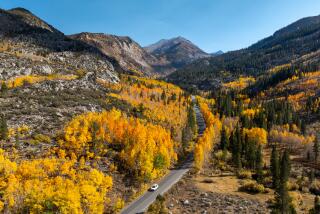Autumn bonanza
- Share via
Although the urban forests of Southern California lack the autumnal glory of Eastern woodlands, fall happens here. We do have trees that shed. Moreover, the annual drop of their canopies by hackberries, sycamores and pecans (to name only a few) is still a bonanza. From these leaves, and just about any leaf that flutters to the ground, comes leaf mold.
What sounds like a disease is nothing more or less than compost made from rotting leaves. Handled right, leaf mold will condition the soil of garden beds and return calcium and other important minerals. It is the best sort of mulch, forming a protective covering that will cool the roots of plants while reducing evaporation and dust.
Some trees mulch themselves. In the case of coast live oaks, avocados and other common semi-deciduous trees, the leaves drop so gradually that all the conscientious gardener usually needs to do is neglect them. Meanwhile, deciduous trees dump so many leaves at once every autumn that doing something with them is an imperative.
Running the leaves under a mower and then spreading them around is a respectable tactic. But if you really have trees, and really have leaves, then you’d be well advised to compost.
To do this, shred the leaves if you can. It’s not necessary, but it will speed up the composting. Then form a pile a decent distance from the house.
Next: Water it occasionally. If decency allows, add urine.
The urea will add nitrogen, which will speed breakdown. Autumn leaves are short on nitrogen because trees withdraw their chlorophyll back into the root system before letting the leaves go. As my brother quipped, using your own urea rather than buying it at home improvement stores will keep you under the radar of Homeland Security.
However you wet the leaves, turn them as you add new loads.
To speed up the composting in a more conventional fashion, add grass clippings. If you don’t have those, ask to raid a neighbor’s green bin.
Better yet, since it’s pruning season, if you have tree-trimmers coming through, request that they bring a grinding truck and leave you the pile of green mulch. This mix of freshly cut wood and leaves will be so full of nitrogen that the pile should start heating up even as the arborists are packing up their saws. Tree trimmings will be ready to spread when they have cooled down and turned brown.
The composting not only will have reduced the volume of leaves and twigs but also will have broken them down to the point that they will not wick water from soil. Rather, they act as a blanket conserving winter rains.
Unlike store-bought mulch, this homemade sort will soon be jumping with life, chiefly earthworms.
Once worms appear, birds will follow. This will be music to your ears.
--
Green’s column on low-water gardening appears weekly on our L.A. at Home blog, latimes.com/home. She also writes on water issues at chanceofrain.com. Comments: home@latimes.com






